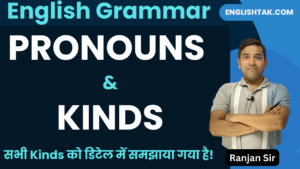![]()
Tense in English Grammar in Hindi
Table of Contents
इस आर्टिकल, Tense in English Grammar in Hindi, में आप सीखेंगे, Tense क्या होता है? Tense कितने प्रकार के होते है? और Tense के कितने States होते है? अगर आप Tense को बिलकुल शुरू से सीखना और समझना चाहते है तो इस पोस्ट को शुरू से अंत तक जरुरु पढ़ें।
INTRODUCTION
The word Tense has been derived from the Latin Word ‘TEMPUS’ which means ‘TIME’. Tense is a grammatical term. Tense refers to a form of the verb that indicates time.
Time is a universal, non-grammatical concept with three divisions – Past, Present and Future; by tense we understand the correspondence between the form of the verb and our concept of time. When making a statement it is essential to indicate whether a situation exists now, existed in the past or is likely to exist in the future.
Tense शब्द लैटिन शब्द ‘टेम्पस’ से लिया गया है जिसका अर्थ है ‘समय’। काल एक व्याकरणिक शब्द है। Tense क्रिया के उस रूप को संदर्भित करता है जो समय को इंगित करता है।
समय एक सार्वभौमिक, गैर-व्याकरणिक अवधारणा है जिसके तीन विभाग हैं – भूत, वर्तमान और भविष्य; काल से हम क्रिया के रूप और समय की हमारी अवधारणा के बीच पत्राचार को समझते हैं। जब हम किसी कोई बात कहते है तो यह इंगित करना आवश्यक है कि क्या कोई स्थिति अभी मौजूद है, अतीत में मौजूद थी या भविष्य में मौजूद होने की संभावना है।
Read More…
100 Sentences of Present Indefinite Tense Hindi & English
DEFINITION
Tense can be defined as follows :
A tense can be defined as that form of a verb which indicates the time and the state of an action or event.
काल को क्रिया के उस रूप के रूप में परिभाषित किया जा सकता है जो किसी क्रिया या घटना के समय और स्थिति को इंगित करता है।
KINDS OF TENSE
There are primarily two tenses in the English language but for convenience we use three tenses corresponding to the three main divisions of time.
अंग्रेजी भाषा में मुख्य रूप से दो काल होते हैं लेकिन सुविधा के लिए हम समय के तीन मुख्य भागों के अनुरूप तीन काल का उपयोग करते हैं।
Read More…
Speaking Practice with Present Tense
Five Tips to Improve Vocabulary
Tense in English Grammar in Hindi
Present, Past and Future.
1. Present tense –
The present tense indicates that the action is done at the present time.
वर्तमान काल इंगित करता है कि कार्य वर्तमान समय में किया गया है।
Examples:
The sun rises in the East and sets in the West.
सूर्य पूर्व में उगता है और पश्चिम में अस्त होता है।
I do not know you.
मैं आपको नहीं जानता हूँ।
2. Past tense –
The past tense indicates that the action took place in the past.
भूत काल इंगित करता है कि कार्य भूतकाल में हुआ था।
Examples:-
She went to Agra last month.
वह पिछले महीने आगरा गई थी।
Rohan did this work for us.
रोहन ने हमारे लिए यह काम किया।
3. Future tense –
The future tense indicates that the action will take place in the future.
भविष्य काल इंगित करता है कि काम भविष्य में होगी।
Examples:-
I shall go to Agra tomorrow.
मैं कल आगरा जाऊंगा।
He will write a book on English.
वह अंग्रेजी पर एक किताब लिखेंगे।
Suggested For You |
|
| Grammar | EnglishTak YouTube Channel |
| Spoken English | Join Our Telegram Group |
| Ranjan Sir Blog | Join Our WhatsApp Group |
Tense in English Grammar in Hindi
Each of these three tenses has subdivisions to show continuity or completeness of the action and the time.
इन तीन काल में से प्रत्येक में क्रिया और समय की निरंतरता या पूर्णता दिखाने के लिए उपखंड हैं।
1. Indefinite (Simple)
2. Continuous (incomplete)
3. Perfect (Complete)
4. Perfect Continuous (complete and incomplete)
1. Indefinite (Simple) –
It denotes that an action takes place regularly, took place regularly or took once and will take place once or reputedly in future.
यह दर्शाता है कि एक क्रिया नियमित रूप से होती है, नियमित रूप से हुई है या एक बार हुई है और भविष्य में एक बार या प्रतिष्ठित रूप से होगी।
Examples:
I write books on English.
मैं अंग्रेजी पर किताबें लिखता हूं।
I wrote a book on English.
मैंने अंग्रेजी पर एक किताब लिखी।
I shall write a book.
मैं एक किताब लिखूंगा।
The action in present, past or future time is mentioned simply without anything being said about the completeness or incompleteness of the action.
क्रिया की पूर्णता या अपूर्णता के बारे में कुछ भी कहे बिना वर्तमान, भूतकाल या भविष्य काल में क्रिया का उल्लेख किया जाता है।
2. Continuous (Imperfect) –
It shows that an action (in present, past or future) is/was still continuing or not yet completed.
यह दर्शाता है कि एक कार्य (वर्तमान, भूतकाल या भविष्य में) अभी भी जारी है/था या अभी तक पूरा नहीं हुआ है।
Examples:
She is writing a book on English.
वह अंग्रेजी पर एक किताब लिख रही हैं।
She was writing a book on English.
वह अंग्रेजी पर एक किताब लिख रही थी।
I shall be writing a book on English.
मैं अंग्रेजी पर एक किताब लिखूंगा।
3. Perfect –
It denotes that the event (in present, past or future) is in a completed or perfect state- present, past or future.
यह दर्शाता है कि घटना (वर्तमान, अतीत या भविष्य में) पूर्ण या पूर्ण स्थिति में है- वर्तमान, अतीत या भविष्य।
Examples:
I have written a book on English.
मैंने अंग्रेजी पर एक किताब लिखी है।
I had written a book on English.
मैंने अंग्रेजी पर एक किताब लिखी थी।
I shall have written on English by the end of this month.
मैंने इस महीने के अंत तक अंग्रेजी में लिख लिया होगा।
4. Perfect Continuous –
It is used to show the completion and incompletion of action in the present, past future.
इसका उपयोग वर्तमान, भूत भविष्य में कार्य के पूर्ण होने और अपूर्ण होने को दर्शाने के लिए किया जाता है।
Examples:
I have been writing a book for two years.
मैं दो साल से एक किताब लिख रहा हूँ।
I had been writing book since January.
मैं जनवरी से किताब लिख रहा था।
I shall have been writing a book from 2023.
मैं 2023 से एक किताब लिख रहा होऊंगा।
New Post from Ranjan Sir
Daily Use English Words with Hindi Meaning – Day-01
Daily Use English Words with Hindi Meaning – Day-02
Quasi Passive Verbs in English





